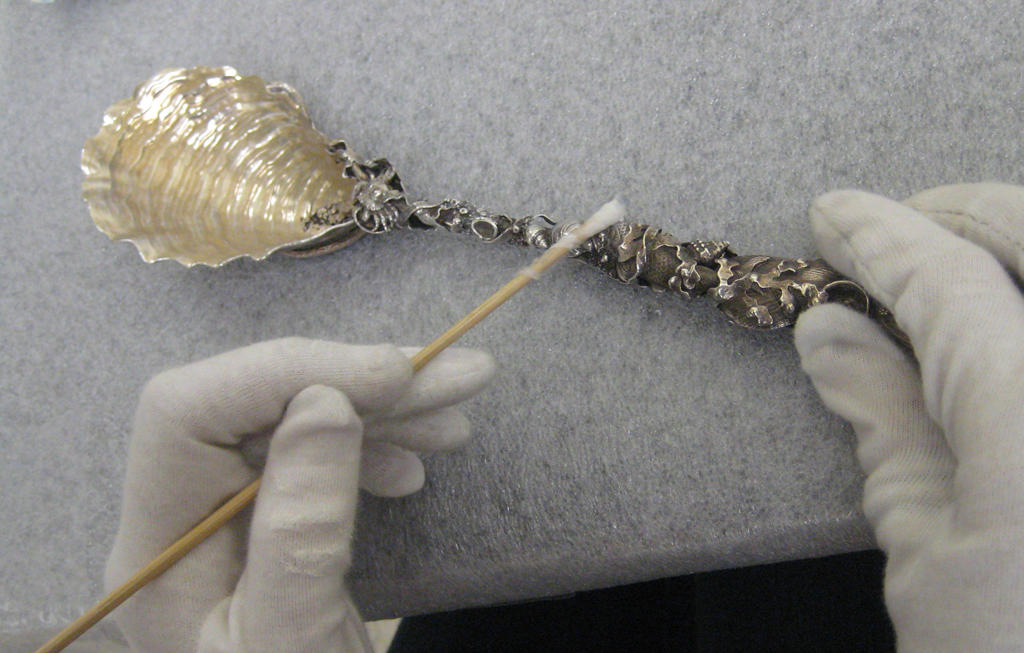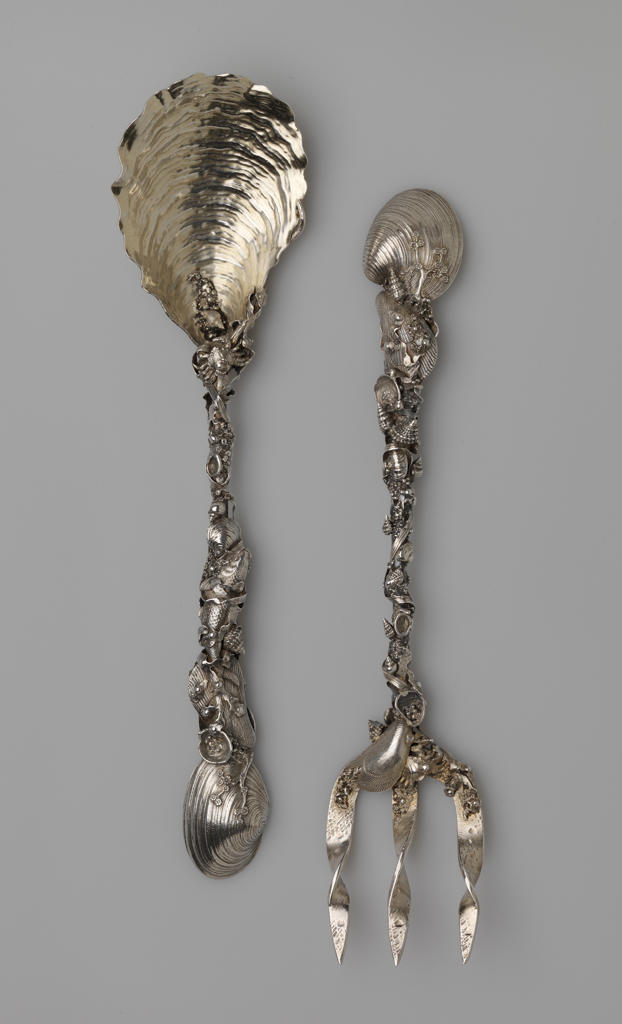My fingers trace a vine of seaweed as it curls around a silver clamshell. Sand, pearls, and other seafloor deposits all cupped in the shell’s underside coalesce to form the handles of the Museum’s Narragansett salad set—a silver serving fork and spoon made by Gorham Manufacturing Company at the end of the 19th century. Ribbons of seaweed wind up the handles of the fork and spoon, entrapping fish, crabs, and seashells in a tangle of oceanic detritus that makes the salad set so special and emblematic of Rhode Island, the Ocean State.
I spent several hours on the top floor of the Museum this past summer, a storage space for the collection’s 3,336 pieces of silver. My Andrew W. Mellon summer internship with Museum conservator Ingrid Neuman heavily revolved around the preparation of art objects for the upcoming exhibition Making It in America. From re-gilding the original frame of Frank Benson’s Eleanor to bleaching hairline fractures in an 18th-century sugar bowl lid, each day at the Museum brought me face-to-face with new conservation opportunities. I grew particularly fond of the silver storage space, with attic windows overlooking Providence, home of the Gorham Manufacturing Company for more than 150 years. Here Ingrid and I worked on polishing the silver that will be displayed in this fall’s show.
Founded in 1831 by master craftsman Jabez Gorham, the Gorham Manufacturing Company quickly became one of America’s most important producers of silverware. Originally Gorham focused on spoons and other small silver objects such as thimbles, combs, and jewelry, but the company expanded in the late 1840s when John Gorham took over his father’s business. Under John’s leadership, the company instituted mechanized manufacturing processes while also expanding the Gorham product line and downtown Providence factory. John Gorham toured Europe in the 1850s, recruiting the finest craftsmen to train his Rhode Island workmen. Gorham silver was soon found in the White House and featured in world’s fairs, praised as some of finest examples of American craftsmanship.
While I cleaned the spoon and fork with cotton swabs and a dilute solution of calcium carbonate and distilled water, elements I originally missed began to come forward. Polishing essentially removes silver molecules from the object’s surface, so the primary goal of my treatment was to clean the high points and preserve fine lines of tarnish that help define ornamentation and details. In addition to the ocean motif, I was fascinated by the Gorham marks stamped on the underside of each utensil. The company’s trademark, no more than 5 millimeters in length, consists of an anchor in the center, a lion to the left, and to the right a capital G in Old English type. Although the specific design of these symbols has slightly varied through the years, the three Gorham trademarks have been consistently used since the 1850s. The marks on the *Narragansett *salad set are comparable to those on other Gorham products from the last quarter of the 19th century.
The salad set tells many stories particular to Rhode Island and its capital city. The nautical decoration speaks to the influence of maritime culture in Rhode Island’s past and present. The utensils look as if they could have been lost at sea for several generations, rediscovered as an amalgamation of ocean life. Steeped in the romantic imagery of the sea, the fork and spoon’s ornamentation evokes an interesting dichotomy between the realities of work in the maritime industry and the elegant lives of the customers who presumably would have enjoyed this set. Even today, the Narragansett salad set is a testament to the Ocean State’s longtime commitment to exceptional creativity and craftsmanship.
Isabella McCormick
RISD BFA Painting 2015, Brown AB Literary Arts 2015
Andrew W. Mellon Summer Intern 2012



